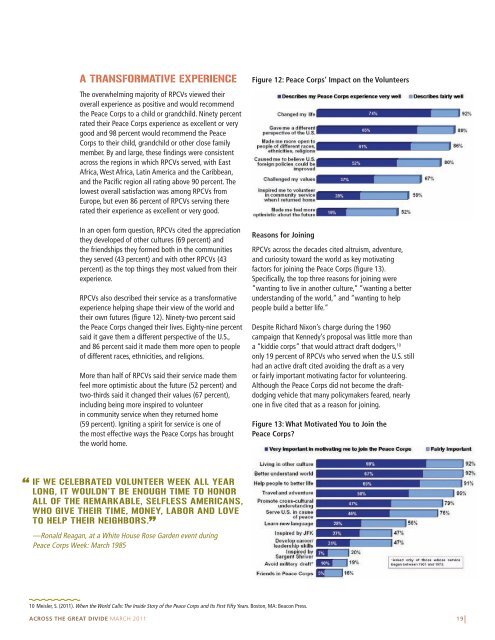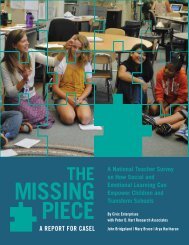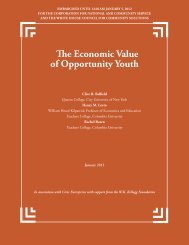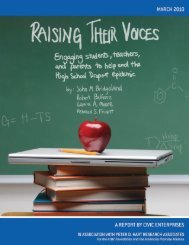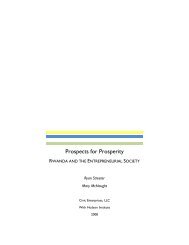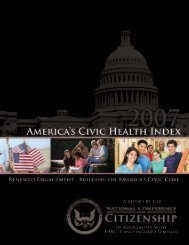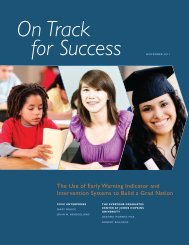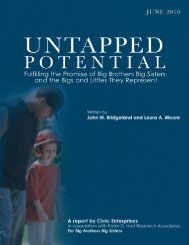| 18RPCVs who have served in the government or the U.S.military were more likely <strong>to</strong> feel that the <strong>Peace</strong> Corps hasimproved U.S. foreign policy and national security, andslightly more likely <strong>to</strong> feel it has helped the U.S. adapt <strong>to</strong>globalization (figure 10).Goal 3: Helping promote a better understanding ofother peoples on the part of AmericansAchieving the third goal of the <strong>Peace</strong> Corps—helpingpromote a better understanding among Americans ofother people and cultures—is a two-step process. Thefirst part is the effect that their <strong>Peace</strong> Corps service hason the perceptions of the Volunteers. The second partinvolves how those RPCVs communicate the deeperappreciation of other cultures gained from service intheir life choices, careers, and <strong>to</strong> their fellow Americans.First, RPCVs in our survey reported a 20-point increasein their attitude <strong>to</strong>ward the community in which theyserved from when they arrived <strong>to</strong> when they left (figure11). Ninety-three percent of RPCVs reported a positive orvery positive attitude <strong>to</strong>ward their host community whenthey completed their service, compared <strong>to</strong> 73 percentwhen they arrived. Twenty-three percent felt neutralabout the community in which they served when theyarrived compared <strong>to</strong> just four percent when they left.Figure 11: What was your attitude <strong>to</strong>ward thecommunity in which you served when you arrivedand when you left?Second, RPCVs reported they brought their experiencehome by applying the skills they learned, speakingabout their experience, and advocating on behalf ofglobal issues and the <strong>Peace</strong> Corps. Nearly two-thirds(63 percent) said they have applied the skills theylearned in the <strong>Peace</strong> Corps <strong>to</strong> their work or anothervolunteer experience. More than half of RPCVs havespoken <strong>to</strong> audiences in the U.S. about their experienceoverseas, with 56 percent speaking <strong>to</strong> groups and 52percent speaking at schools. And 1 in 5 have advocatedlawmakers on global issues (21 percent) or for the <strong>Peace</strong>Corps (18 percent).Case Study: Recreating the <strong>Peace</strong> Corps experience forteachers at homeTHE STORY OF BRIAN GLENN ANDFRAN HUCKABYThe lifeblood of the <strong>Peace</strong>Corps lies with the s<strong>to</strong>riesof friendship, understandingand sustainabledevelopment and thepowerful multiplier effectthose s<strong>to</strong>ries portray.Brian Glenn and Fran Huckaby, Pho<strong>to</strong> courtesyof NPCA.Twelve years ago, BrianGlenn and Fran Huckaby(Papua New Guinea1997-99) served as Rural Community Development Facilita<strong>to</strong>rsin six rural villages in the Eastern Highlands Province. The coupleexemplified the important role of “facilita<strong>to</strong>r” as they worked withthe community <strong>to</strong> select local teachers and elect a communityschool board. They assisted with curriculum development andteacher training programs. They helped secure grants that led <strong>to</strong> theconstruction of six K-2 schools. Construction and planning addressedother needs <strong>to</strong>o, as each school included a catchment tank fordrinking water, and a small community library. There was also a grant<strong>to</strong> provide travel support for a community health worker.The impact of this <strong>Peace</strong> Corps success s<strong>to</strong>ry does not, however, endin the remote villages of a country <strong>to</strong>o many Americans would behard pressed <strong>to</strong> find on a map. It extends <strong>to</strong> the campus of TexasChristian University (TCU).As an Associate Professor in the College of Education at TCU, Franregularly applies some of her <strong>Peace</strong> Corps experiences as sheprepares the next generation of classroom teachers. When teachingcourses such as Diversity in American Education, or Philosophyand Ethics in Education, Fran often refers back <strong>to</strong> her <strong>Peace</strong> Corpsexperiences. Occasionally, Fran has a “PNG (Papua New Guinea)Day” in her classroom. She sets up the classroom like a PNG village,speaks <strong>to</strong> the college students only in the local language (“I can dothis because I haven’t run in<strong>to</strong> anyone yet who speaks MelanesianTok Pisin!”) and then has the students take a test. The exercise isdesigned <strong>to</strong> give her future teachers the feeling of what it mightbe like for some of their future students who may speak a differentlanguage and be unfamiliar with the local environment, cultureand cus<strong>to</strong>ms.This summer the couple traveled back <strong>to</strong> Papua New Guinea. Whilethey didn’t know exactly what <strong>to</strong> expect upon their return, the RPCVsdid know that several of the schools they started—perhaps four orfive of them—received local government recognition and are stilloperating. “That means the government is now providing resources<strong>to</strong> support the schools and the teachers,” said Brian.For Fran, one purpose is <strong>to</strong> update her cultural knowledge of thecountry. She also plans <strong>to</strong> lay the groundwork for an interdisciplinarystudy abroad program in which TCU students would learn—not bystudying simply in an overseas university classroom—but more bytraveling <strong>to</strong> various communities around the country. If launched,Fran and Brian believe the program could be the first study abroadprogram <strong>to</strong> PNG in the nation.ACROSS THE GREAT DIVIDE MARCH 2011
A TRANSFORMATIVE EXPERIENCEThe overwhelming majority of RPCVs viewed theiroverall experience as positive and would recommendthe <strong>Peace</strong> Corps <strong>to</strong> a child or grandchild. Ninety percentrated their <strong>Peace</strong> Corps experience as excellent or verygood and 98 percent would recommend the <strong>Peace</strong>Corps <strong>to</strong> their child, grandchild or other close familymember. By and large, these findings were consistentacross the regions in which RPCVs served, with EastAfrica, West Africa, Latin America and the Caribbean,and the Pacific region all rating above 90 percent. Thelowest overall satisfaction was among RPCVs fromEurope, but even 86 percent of RPCVs serving thererated their experience as excellent or very good.In an open form question, RPCVs cited the appreciationthey developed of other cultures (69 percent) andthe friendships they formed both in the communitiesthey served (43 percent) and with other RPCVs (43percent) as the <strong>to</strong>p things they most valued from theirexperience.RPCVs also described their service as a transformativeexperience helping shape their view of the world andtheir own futures (figure 12). Ninety-two percent saidthe <strong>Peace</strong> Corps changed their lives. Eighty-nine percentsaid it gave them a different perspective of the U.S.,and 86 percent said it made them more open <strong>to</strong> peopleof different races, ethnicities, and religions.More than half of RPCVs said their service made themfeel more optimistic about the future (52 percent) andtwo-thirds said it changed their values (67 percent),including being more inspired <strong>to</strong> volunteerin community service when they returned home(59 percent). Igniting a spirit for service is one ofthe most effective ways the <strong>Peace</strong> Corps has broughtthe world home.Figure 12: <strong>Peace</strong> Corps’ Impact on the VolunteersReasons for JoiningRPCVs across the decades cited altruism, adventure,and curiosity <strong>to</strong>ward the world as key motivatingfac<strong>to</strong>rs for joining the <strong>Peace</strong> Corps (figure 13).Specifically, the <strong>to</strong>p three reasons for joining were“wanting <strong>to</strong> live in another culture,” “wanting a betterunderstanding of the world,” and “wanting <strong>to</strong> helppeople build a better life.”Despite Richard Nixon’s charge during the 1960campaign that Kennedy’s proposal was little more thana “kiddie corps” that would attract draft dodgers, 10only 19 percent of RPCVs who served when the U.S. stillhad an active draft cited avoiding the draft as a veryor fairly important motivating fac<strong>to</strong>r for volunteering.Although the <strong>Peace</strong> Corps did not become the draftdodgingvehicle that many policymakers feared, nearlyone in five cited that as a reason for joining.Figure 13: What Motivated You <strong>to</strong> Join the<strong>Peace</strong> Corps?“IF WE CELEBRATED VOLUNTEER WEEK ALL YEARLONG, IT WOULDN’T BE ENOUGH TIME TO HONORALL OF THE REMARKABLE, SELFLESS AMERICANS,WHO GIVE THEIR TIME, MONEY, LABOR AND LOVETO HELP THEIR NEIGHBORS.”—Ronald Reagan, at a White House Rose Garden event during<strong>Peace</strong> Corps Week: March 198510 Meisler, S. (2011). When the World <strong>Call</strong>s: The Inside S<strong>to</strong>ry of the <strong>Peace</strong> Corps and Its First Fifty Years. Bos<strong>to</strong>n, MA: Beacon Press.ACROSS THE GREAT DIVIDE MARCH 201119|


